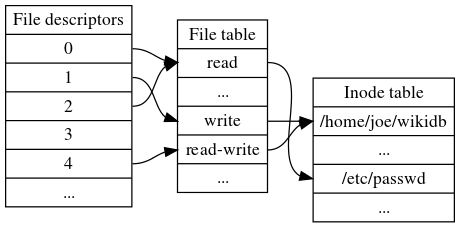Linux File System Calls
To the kernel, all open files are referred to by File descriptors. A file descriptor is a non-negative number. When we open an existing file or create a new file, the kernel returns a file descriptor to the process. When we want to read or write a file, we identify the file with the file descriptor.
Each Linux process (except perhaps a daemon) should expect to have three standard POSIX file descriptors:
| POSIX Constants Name | File Descriptors | Description |
|---|---|---|
| STDIN_FILENO | 0 | Standard input |
| STDOUT_FILENO | 1 | Standard output |
| STDERR_FILENO | 2 | Standard error |
There are three "system file tables":
- There is a file descriptor table that maps file descriptors (small integers) to entries in the open file table.
- Each entry in the open file table contains (among other things) a file offset and a pointer to the in-memory inode table.
- In open file table, one file table entry has an
open()call, and it is shared if the file descriptor isdup()edorfork()ed.

Figure: file descriptors for a single process, file table and inode table.
Note that
- multiple file descriptors can refer to the same file table entry (e.g., as a result of the dup system call);
- multiple file table entries can in turn refer to the same inode (if it has been opened multiple times; the table is still simplified because it represents inodes by file names, even though an inode can have multiple names).
- File descriptor 3 does not refer to anything in the file table, signifying that it has been closed.